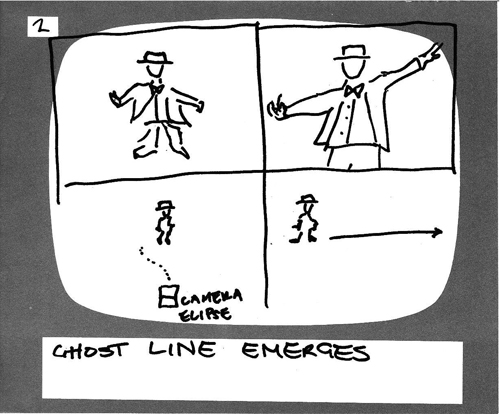Cori Olinghouse on “Ghost Lines”
December 10, 2013
Cori Olinghouse: In this process, I’ve been inspired by early silent film and the mechanics of the moving image. Inspired by what I perceive to be a confluence of forms, I’m drawn to the visual rhythmic impulses shared by silent film, eccentric dance, Vaudeville and the experimental avant-garde around this same era.
I wanted to travel back through various historical movements to explore what images haunt us, what meaning is locked in our collective unconscious. The ghost characters in Ghost lines are conduits – going back and forth in time, ambiguously located, summoning the material presence of this history re-configured. We also play with various ideas of line. In recalling my childhood memory of The Dot and the Line by Chuck Jones, I love all the various characters created when the line was squashed, stretched and so on.
I wanted to manipulate the comedy of line in all its forms – character line, gestural line, historical line, visual line, and rhythmic line. I love how line can take on aspects of humor. Lines can shape-shift. As the ghost characters, this gave us direction for how to channel a multiplicity of form and meanings.
I’ve also been inspired by Keaton as an unintentional surrealist (written about in “The Theater and Cinema of Buster Keaton” by Robert Knopf) and the proposition that Vaudeville is a site for the surreal. In his book, Robert describes that “many of the techniques the surrealists used in their artistic explorations overlap with those used in vaudeville comedy: the double meaning of objects and words, verbal and visual puns, the juxtaposition of two disparate images, the animation of inanimate objects, and the disruption of narrative continuity, time, and space.”
In working with film artist, Shona Masarin, I was drawn further to the tactile, kinetic and deeply rhythmic aspect of her work. She plays with the anatomy of the moving image, exploring the kinetics of 24 still frames per second. This play of elasticity and timing was a source of inspiration for the film and live performance. In our process for the live choreography, I wanted to create the illusion of narrative through pace changes. Colin Gee (dramaturg) offered his own interpretation of scenes from silent melodramas, broken into size and pace changes. This was an incredible delight – to play with the illusion of narrative through size and pacing. Below is an excerpt from one of these scenes:
SILENT MELO 1
slow, small (hero enters)
medium, medium (heroine enters)
very slow, small (hero advances toward her)
medium, big (villain enters)
fast, big (hero leaves)
very slow, big (heroine vacillates between fleeing or not)
fast, small (villain follows)
slow, small (heroine follows)
fast, big (hero and heroine escape)
medium, big (villain foiled)
Another huge source of inspiration has been to work with veteran tap artist, Michelle Dorrance – exploring tap footwork as visual line drawings. Together we looked at Dada films from the 1920’s and played with tap in a visual, textural, kinetic framework. The following list includes a series of vocabularies that we played with:
heel toes
alternating heel tow – tow heel rolls
non-linear staccato
non-metered repetition
traveling angular sliding phrase in time with visual geometry as focus
5 count riff
crawls
crawls with toe clicks
sliding (thick marker / felt – continuous)
scribbles (non continuous – take pen off page)
sketching
fake out – followed by jumps with real shit
toe heel angle
relaxed techniques – quieter
lightning bolt (short duration – spurts)
wind – being pushed
line drawing from memory of real drawing
non-sequitor scribble- switching modes
with timing:
crawl with subdividing the measure / with accents
slides – in ¾ – swing (syncopating & triplet notes)
relaxed techniques freestyle in time
scribble – musical feel
This exploration of abrupt, non-sequitor and strange rhythms has been a deep source of inspiration. I’ve begun to witness more possibility of merging the rhythmic impulses of silent film and clown with the non-sequitur absurdist timings of the surrealists – colliding through the use of absurd associative logics.
In Shona’s words:
My relationship to the materials I work with informs my approach to structure. Because I am able to hold the filmstrip in my hands and see the progression of movement as it relates to the single frame, I am drawn to the mechanics of the medium as it relates to perception, kinetics, and optical illusion. I play with the patterns I find within the anatomy of a moving image: within the 24 frames per second. I look for rhythms and startling chance compositions that confuse, seduce, and assault the senses. My films are often comprised of seemingly unrelated images strung together to create a kind of quasi-narrative structure. This is very similar to the way Cori constructs her lines of movement. When shooting and editing, I break down her movement into frames, and from there I play with the illusion of movement, the same way we both play with the illusion of a narrative.
In this project, we wanted to collaborate on a new language – where our respective mediums communicate through their physicality and rhythm, solidifying a connection between the slapstick of the camera and the slapstick of the body.
We wanted to employ traditional cinematic conventions, and at other times slip into another world where the action merges, or interacts with the emulsion, carrying the tactile mark of my hand. Within this hand-marked intervention, we play with the image of the silent clown and the shapes they take up, repositioning silent comedy by intervening and abstracting it, highlighting the materiality and physicality of the clown, rather than the narrative of the clown.
Check out Cori’s own tumblr: ghostlinesproject.tumblr.com
***
Ghost lines runs Thursday, December 12- Saturday, December 14


